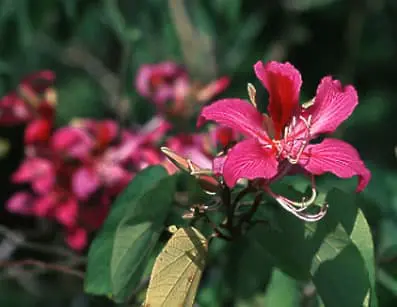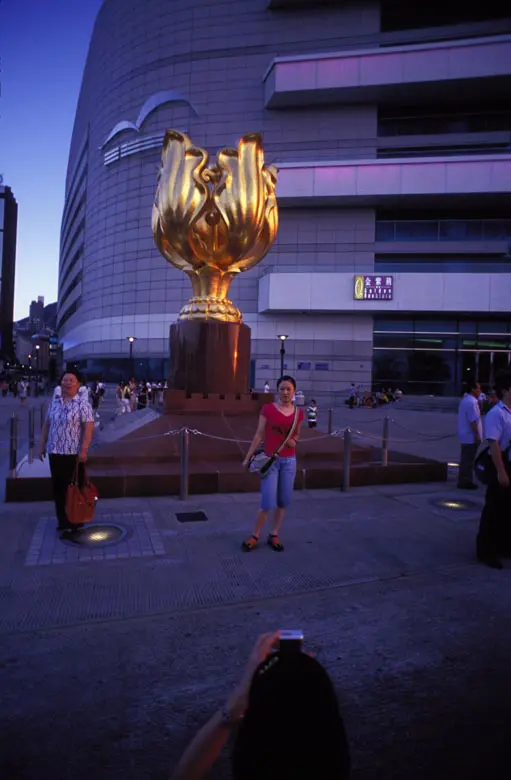
For much of the year, one of the commoner trees in Hong Kong’s city parks and gardens looks rather nondescript. It never grows more than around eight metres high, and there’s little distinctive about it except leaves shaped like camel’s feet – which are hardly the epitome of style. Don’t let this unassuming appearance deceive you: this tree is special in several ways. In late winter, it explodes with the blooms that give rise to its common English name – Hong Kong orchid tree – and which have been adopted as the emblem of Hong Kong.
Known as Bauhinia blakeana in scientific parlance, the Hong Kong orchid tree is something of an enigma. Rather than being allied to what many of us think of as “real” trees, it’s a legume, which means its close kin include not oaks and sequoias, but the common or garden pea. Then, it could be that every Hong Kong orchid tree alive today is descended from a single tree. And, even though the flower has been Hong Kong’ s emblem since 1965, no one is sure if the tree is a true species, or a hybrid.
The first scientific description of the Hong Kong orchid tree was published in 1908, by S.T. Dunn, superintendent of the Botanical and Forestry Department. Dunn assigned it to the Bauhinia genus, and named it after Sir Henry Blake, who was Governor of Hong Kong from 1898 to 1903 and had a strong interest in botany.
But Dunn did not discover the Hong Kong orchid tree. His description was based on one in the Botanical Gardens – and this had been grown from a cutting taken from trees cultivated in the French Mission at Pokfulam, on the west coast of Hong Kong Island, which in turn were derived from a tree (or trees) found nearby. Dr Lawrence Ramsden of the University of Hong Kong’s Department of Botany notes that in his 1903 report on the gardens, Dunn, referred to these first specimens being discovered “20 to 30 years ago”. Based on this, he estimates the discovery was made in 1880.
Though hazy about the date, Dunn described the discovery as involving a “tree”, implying just one unique individual was found. As far as is known, all the French Mission cuttings were taken from this tree, so all Hong Kong orchid trees today are clones of the original tree – which is the only wild one yet found. This, says Ramsden, makes B. blakeana susceptible to decimation by epidemics, though it has evidently so far avoided major diseases.
Hong Kong orchid trees are usually sterile, leading botanists to think they don’t belong to a true species, but a hybrid. Yet here, too, there are uncertainties. One tree has been found in Hong Kong that produces seeds, perhaps indicating that the Hong Kong orchid tree is a species in its own right. In a bid to settle the hybrid/species debate, Ramsden is conducting research that includes genetic analysis of the Hong Kong orchid tree and its close relatives. He is also keen to find out if there are any more individuals that can produce seeds – if so, they could benefit propagation of the tree for horticulture.
The Hong Kong orchid tree is now widely planted as an ornamental within the SAR and many other tropical countries. So, whether or no you’re intrigued by its origins and status, you may have the opportunity to enjoy the sight of the tree in flower, with its exuberant, purple magenta blooms looking as if they indeed belonged to an orchid rather than a tree. In Hong Kong, the flowering season usually begins around December and closes in March, though Dr Ramsden found the 1998/1999 season lasted an exceptional nine months, with massed flowers in early winter and some trees in bloom as late as June.
If you’re in Hong Kong outside the flowering season, and you want a reminder of the flowers’ beauty, all you have to do is reach into your pocket and pull out some coins. Where the Queen’s head once occupied one side of every coin, you’ll invariably find the bauhinia flower now reigns supreme.

A historical account of our city flower, Bauhinia x blakeana

Bauhinia Tree Article
Hello,
I’m a landscape contractor here in San Diego. You mentioned that this tree does not seed. I have a few right now on my properties that have lost a lot of leaves recently and now have numerous seed pods hanging from the branches. If this is of interest you can email me at hybridls@san.rr.com.
Thanks,
Daryl W. Stock
Seeds on Hong Kong Orchid Tree
My tree in Houston also had multiple seed pods and many, many seedlings every year. I have since moved from that location and brought a seedling with me, but so far it has not bloomed. The original tree should still be alive and producing seeds — unless our hard freezes last year killed it. I am hoping my tree will bloom next year.